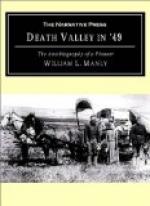I spent five months with a wholesale grocery and miners supply firm, Elder and Smith, Fourth and J streets, Sacramento, and three months in the mines as a drummer, or solicitor and collector for the same firm. I returned to Sacramento and was almost ready to start home when the Scots River excitement broke out. I then went to the mines on Trinity River and associated myself in mining with Hiram Gould, a young Presbyterian clergyman who had laid aside the “cloth” for the time and engaged in mining. I remained in the mines until July fourth, 1851, exactly one year from the time I entered Sacramento, when I started home by way of Nicaragua. In due time, after an interesting trip, I arrived home and again entered upon the study of my chosen profession, graduated from an honorable college, and am now, as you know, practicing my profession on the sea shore.
M.S. MCMAHON.
CHAPTER XIII.
STORY OF THE JAYHAWKERS.
In the foregoing chapters describing the trip across the deserts and mountains, the author has had occasion many times to refer to the “Jayhawkers.” Their history is in many respects no less remarkable and intensely interesting than that of his own party. The author has therefore collected many notes and interviews with prominent members and presents herewith the only written history of their travels.
The little train afterward known by this name was made up in the state of Illinois in 1849, of industrious, enterprising young men who were eager to see and explore the new country then promising gold to those who sought. The young men were from Knoxville, Galesburg and other towns. Not all were influenced by the desire for gold. It was said that California had a milder climate and that pleasant homes could there be made, and the long, cold winter avoided.
They placed some of the best men in position to manage for the whole. The outfit was placed on a steam-boat and transported to Kanesville, on the Missouri River above Council Bluffs. Some of the company went with the goods while others bought teams and wagons in Western Missouri and drove to the appointed place. Kanesville was a small Mormon camp, while Council Bluffs was a trading post of a few log cabins on the river bank, inhabited mostly by Indians. There was no regular ferry at either place, and our party secured a log raft which they used to get their wagons and provisions across, making the oxen swim.
They asked all the questions they could think of from everyone who pretended to know anything about the great country to the west of them, for it seemed a great undertaking to set out into the land they could see stretching out before them across the river. Other parties bound the same way, also arrived and joined them. They chose a guide who claimed to have been over the road before. When all were gathered together the guide told them that they were




